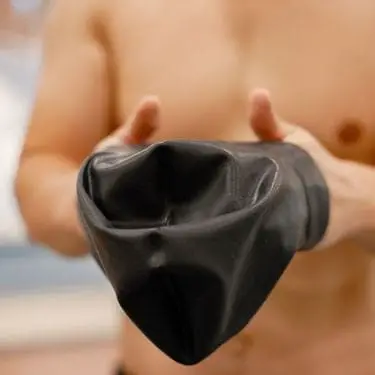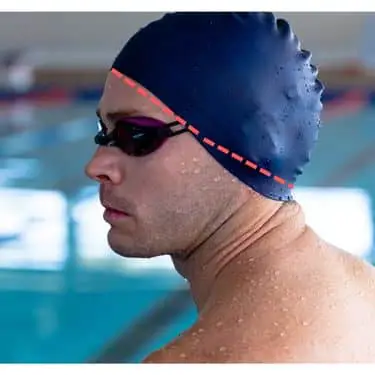It’s hard to know what a good swim cap fit is supposed to feel like when wearing a swim cap for the first time. It is likely that you have never worn anything similar on your head before, so at first, it can feel weird and uncomfortable.
For many years I disliked swim caps as they were too large, too small, or pulled on my hair. However, from experimenting with the different swim caps on the market, I found one that is just right and will never be in the water without it.
Typically, your swim cap should be tight enough to remain in place as you swim. Ideally, a snug fit is required to ensure that your swim cap does not fall off. However, if your swim cap is leaving deep marks on your forehead or is painful, then it is too tight.
When you finally find a good swimming cap fit, you will not notice it on your head. You should be able to easily fit your cap, even with long hair, and have it sit in place without adjustments as you swim.
In this article, I will cover the fundamentals of finding a good swim cap fit, covering:
- How tight should a swim cap be?
- How do you know if your swim cap is too small?
- Do swim caps stretch over time?
- How do you size a swim cap?
- What is the best swim cap for a large head?

How Tight Should A Swim Cap Be?
A swim cap should be tight enough to give a snug fit and stay in place as you swim. You should not be aware of your swim cap as you swim and if you experience any pain such as a squeezed forehead, then it is too tight.
The vast majority of swim caps are one size, which means they will stretch to accommodate a wide variety of head sizes.
This is okay for most of the population with an “average” size head. However, if your head is larger, then you may need to look for swim caps that can accommodate a larger crown such as swim caps labelled as larger or extra large.
The material of the swim cap is an important factor in getting a snug fit.
The most common swim cap materials are:
- Silicone
- Latex
- Polyester / Lycra
To the untrained eye, the silicone and latex swim caps feel like soft rubber, and the polyester and lycra swim caps feel like a cloth material to touch.
The following table summarises how swimming cap material can affect swim cap fit:
| Swim Cap Material | Swim Description | Swim Cap Fit |
|---|---|---|
| Silicone | This is a soft rubber, good for those with delicate skin. These swim caps are often undersized in comparison to latex, but stretch really well to accommodate all head sizes. Excellent for fitness, swimming and competing. | Snug and comfortable fit. Will stretch to accommodate large heads. Extra large swimming caps in silicone are also on the market for larger crowns. |
| Latex | This is a soft rubber, but bad for those with latex allergies. These swim caps are often larger, however, they do not stretch as much as silicone so can tear more easily. The latex can grab and pull hair, which may feel uncomfortable for some. | A snug fit but will pull on longer hair. Often larger due to the lack of stretch. |
| Polyester / Lycra | These are material swim caps. They are good for recreational swimming but not so good for fitness training where your head is in the water. They are generally the most comfortable swim caps to wear, however, will come off easily if your head is always underwater. | Very comfortable fit for recreational swimmers. Will be loose on the head. |
How Do You Know If Your Swim Cap Is Too Small?
Some mild squeezing is expected when you first put on a new swimming cap as it stretches to accommodate your head. However, how do you know if your swim cap is too small?
If your swim cap is painful, causing you headaches or leaving deep marks on your forehead, then it is too small.
After four lengths of swimming with a new swim cap, you should not be aware of it. You may need some slight adjustment if you have long hair and need to tuck in a few strands that you missed, but otherwise, there should be no need to adjust your swim cap as you swim.
If you think your swimming cap is too small or feels too tight, check the following:
1. Is It A Youth Cap?
Many adults, myself included, are attracted to the bright and funky designs on swimming caps. Unfortunately, most of the fun swim cap designs are on youth caps, which are smaller.
As most swimming caps can stretch a considerable amount, even a youth cap will most likely fit on an adult-sized head. However, it could feel overly tight.
Check that your swim cap is an adult swimming cap before purchasing a new extra-large cap.
2. Where Is The Seam?
The seam of your swimming cap should run down the centre of your head when fitted. If not, your swim cap could feel uncomfortable and have a poor fit.
If you cannot see any obvious seam which is common with silicone caps, in particular, lay the swimming cap on a flat surface.
The ridge along the top of the cap (the direction shown in red in the following image) should run down the middle of your head.

Do Swim Caps Stretch Over Time?
Although swimming caps do stretch over time, the constant exposure to chlorine causes the material to degrade and become less elastic.
I keep all my old swimming caps, not just for nostalgia, but because it helps me learn how the material behaves over time.
Your swimming cap may feel absolutely fine, however when you buy a new swimming cap and compare it to your old one you will feel a difference in the material.
For example, my favourite swimming cap is the Speedo Plain Moulded Silicone Swim Cap.
When you compare a new silicone swim cap to a used one, you can feel that the material in the new cap is tighter and more flexible. The used silicone caps have been stretched and have less “bounce” in the material.
In addition, new silicone swim caps feel softer to the touch than used silicone caps.
Although swimming caps do stretch over time, the chlorine has a degrading impact on the swim cap material.
How Do You Size A Swim Cap?
The vast majority of swimming caps on the market are sized as “one size”. This means that they should stretch to accommodate a wide variety of head sizes.
Some swimming manufacturers give a size guide and alternative swimming cap sizes, such as the Arena 3D Soft Swim Cap.
Generally, the circumference of the crown is measured to fit a swimming cap if a manufacturer does specify a size. To do this, measure the diameter of the widest part of the head, just above the eyebrows.
For example, a manufacturer may specify a swimming cap with sizes small, medium and large. To check your fit, you will need to measure the circumference of the crown as highlighted in red in the following image:

As there is no general sizing guide, you will then need to check the specific size of the swimming cap you are interested in to get the right size.
What Is The Best Swim Cap For A Large Head?
For swimmers with a large crown circumference (24″ plus), it is difficult to find a swimming cap that does not feel very tight.
Remarkably, the swimming market seems to have ignored those with very large heads.
On average, most elite swimmers will wear some form of moulded silicone swimming caps for races as they give a streamlined head profile and are a snug fit. They will generally wear latex during training, as latex is much lighter, so their heads do not get as hot during a hard workout.
For those who have heads that are larger than average, some experimentation is needed. Although latex generally has a wider crown profile, latex will not stretch as much as silicone. It could be argued that silicone is the better option for swimmers with a large head profile.
Some swimmers argue that swimming caps for long hair are the solution, however, this is not the case. The crown circumference of a long hair swim cap will be about the same as one-size caps. The only difference is that long-hair swim caps have a bigger volume to accommodate long hair.
Although this could be an option for swimmers with large heads, if your problem is that your forehead is being squeezed, then long hair caps will not necessarily help.
There are some swim caps that come in extra large. Although not guaranteed to fit, they are the best bet for those with a larger crown profile.
From my experience, I have found that the standard silicone one-size swim cap from Zone 3 works best when it is hard to get a good fit – either with a head that is too big or too small.
This swim cap is made from very soft silicone that stretches really well and could be a safe and cheap bet for a swimmer with a large head. This swim cap should stretch to fit even those who wear extra-large bike helmets.

Final Thoughts
A good swimming cap is one that you are not aware of as you swim. Your swimming cap should be tight enough to be a snug fit without overly clamping or squeezing your forehead or causing pain.
Swimming caps stretch over time, but chlorine has a degrading impact on the swim cap material.
The vast majority of swimming caps are sized as “one size”, although some manufacturers do give a size guide. For swimmers with a large crown circumference (24″ plus), it is difficult to find a swimming cap that does not feel very tight.
Some swimmers argue that swimming caps for long hair are the solution, however, this is not the case. Swimming caps that come in extra large are the best bet for those with a larger crown profile.
